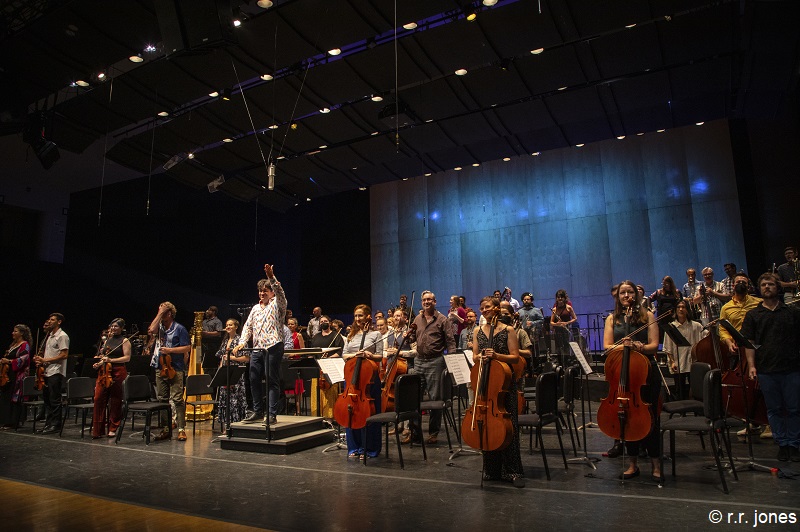
CABRILLO MUSIC: THE MOUSE THAT ROARS
SANTA CRUZ, CA—–The biggest little festival of all might just be the Cabrillo Festival of Contemporary Music, which for years has featured living composers’ output exclusively while garnering dozens of ASCAP awards for adventurous programming.
Now 62 years old, this cutting-edge orchestral package of national impact performs over two midsummer weekends in music that is complex, audacious and often brand new, with most of the composers present to witness their music from start to finish. This year, there were 16, featuring the prominent figures Wynton Marsalis, Gabriella Smith and Pierre Jalbert, with Music Director Cristian Mãcelaru on the podium—all well attended by the faithful despite the 1,000-seat-capacity auditorium.
Despite, yes, because this time-tested enterprise in a beach-and-boardwalk community deserves far better facilities. Most of the audience in the century-old Santa Cruz County Auditorium, best known for boxing matches, sits in grandstands with aisles having steeply raked stairways. The lack of hand-rails makes every descent a safety hazard, particularly for the seniors who make up a big part of the subscribers. You might be happy enough to accept the bare-bones concrete, but less so with the dim lighting, making even the reading of the program a challenge. There is a long-established “Friends of” study and fund-raising group for the SCCA, and now a new Executive Director, D. Riley Nicholson, who might eventually turn things around, hopefully before some music lover break a leg or neck on those stairways. Spending the last 34 years in the inadequate SCCA, one might say, is purgatory enough for the financially challenged but prime-quality festival.
The orchestra may play in shirt sleeves, and show few gray hairs, but don’t be fooled; they hail from all over the country, players on the way up from 27 different states. The diffuse sound in the hall prevents fine evaluation or close ensemble criteria. But they work through deucedly difficult music such as Errollyn Wallen’s 26-minute, three-movement Violin Concerto, in which soloist Philippe Quint played a highly dissonant work that nearly had me dabbing at perspiration on my own face.
Pierre Jalbert’s “Passage” meanders over many kinds of passages in his easy-going style, running in restless, relentless music. Later comes a mysterious murkiness of pregnant drama—a distant voice, a punctuating chord, subtle clarinet solos, and an allusion to Beethoven’s Symphony No. 4. Then episodic elements, anticipation, and fast traveling, as if part of a film score.
Imagine that composer Charles Ives was Mexican, and you have some feel for Juan Pablo Contreras’ blur of countless mariachi ensembles in Jalisco, each on its own wavelength, within “Mariachitlán:” a mariachi jam, if you will. Given the constant shifts of meter, you wonder how a conductor can maintain any semblance of sanity. But Mãcelaru glues his eyes on the score all night long with nimble baton and salutary results.
The other work in the Aug. 11 finale was Clarice Assad’s Brazilian “Baião N’ Blues,” a jazzy piece with trumpet, full of stops and starts.
MUSIC NOTES—When presented with a large flower bouquet at the Aug. 11 concert finale, conductor Mãcelaru dashed to the percussion section, handing them over to Principal Galen Lemmon, soon to retire after 27 seasons here. He and his wife have pledged their entire percussion inventory of 430 instruments to the festival….A delayed broadcast of this concert is slated for 6 pm Sept. 22 on KALW 91.7, San Francisco…Longtime attendees are legion at Cabrillo; this critic has been at more than 55 of the 62 Cabrillo seasons, probably fewer than certain patrons.
FINALE CONCERT, 2024, of the Cabrillo Festival of Contemporary Music, Aug. 11, Santa Cruz (CA) County Auditorium, Santa Cruz, CA. For festival info: www.CabrilloMusic.org.